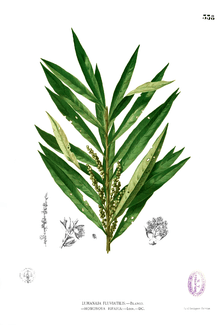Homonoia riparia
Homonoia riparia, the willow-leaved water croton,[4] a mangrove species, belongs to the genus Excoecaria of the family Euphorbiaceae. The plant is widely distributed through South Asian and South East Asian countries such as Cambodia, China, Indonesia, Laos, Papua New Guinea, Philippines, Sri Lanka, Taiwan, Thailand and Vietnam. It is grown in wet soil near river banks and flooded plains.[5]
| Willow-leaved water croton | |
|---|---|
 | |
| Homonoia riparia[1] | |
| Scientific classification | |
| Kingdom: | Plantae |
| Clade: | Tracheophytes |
| Clade: | Angiosperms |
| Clade: | Eudicots |
| Clade: | Rosids |
| Order: | Malpighiales |
| Family: | Euphorbiaceae |
| Genus: | Homonoia |
| Species: | H. riparia |
| Binomial name | |
| Homonoia riparia | |
| Synonyms | |
| |
Description
- Bark - brownish
- Leaves - simple, and alternate
- Flowers - wind pollinated monoecious flowers and bracts sub-ovate
- Height - 1–3-metre-tall evergreen shrub
- Ecology - A rheophyte
- Uses - medicine
Common names
The names are according to Asian Plant.net and Indian Flowers
- Borneo - Bongai tidong, Parang-parang
- Burma - Kyauk(a)naga, Momaka, Nyin ye bin.
- Cambodia - Rey tuck.
- China - Shui liu, shui yeung mui.
- English - Willow-Leaved Water Croton.
- India
- Hindi - Sherni (शेरनी)
- Marathi - Raan kaner (रान कणेर)
- Tamil - Kattalari (காட்டலரி)
- Malayalam - Neervanchi, Puzhavanchi
- Telugu - Adavi ganneru (అడవి గన్నేరు)
- Kannada - Hole nage, Niru kanigalu (ಹೊಳೆ ನಗೆ)
- Sanskrit - Kshudrapashanabheda (क्षुद्रपाषाणभेद)
- Java - Kajoe soebah, Keding djati, Soebah/Sobah,
- Laos - Kek khay.
- Philippines - Agooi, Agoioi, Agukuk,
- Thailand - K(l)ai nam, Klai hin, Mai kerai, (Ta)kri nam.
- Sri Lanka - Omi (ඕමි), Werawala (වැරවල)
- Sumatra - Sangka, Sangkir
- Vietnam - Cây rù rì nước, Rì rì, Rù rì.
gollark: Perhaps umwn is also 12 and simply reading a thesaurus quite fast.
gollark: The sesquipedalian loquaciousness of umwn is impressive.
gollark: Watch for any papers on stuff like this.
gollark: They're studying how 12 year olds interact with a world of strange broken physics in a somewhat weird economy.
gollark: Well, actually, it now hangs from an end island, which itself is unsupported.
References
- 1880 illustration from Francisco Manuel Blanco (O.S.A.) - Flora de Filipinas
- Kumar, B. (2011). "Homonoia riparia". The IUCN Red List of Threatened Species. 2011: e.T176888A7325105. doi:10.2305/IUCN.UK.2011-1.RLTS.T176888A7325105.en. Retrieved 5 December 2017.
- http://www.theplantlist.org/tpl/record/kew-100133
- http://iucnredlist.org/details/176888/0
- http://www.biotik.org/india/species/h/homoripa/homoripa_en.html
Further reading
- Yang, SM; Liu, XK; Qing, C; Wu, DG; Zhu, DY (2007). "Chemical constituents from the roots of Homonoia riparia". Yao Xue Xue Bao. 42 (3): 292–6. PMID 17520829.
External links
- Asianplant.net: Homonoia riparia
- Park, Seonju; Nhiem, Nguyen Xuan; Van Kiem, Phan; Ban, Ninh Khac; Kim, Nanyoung; Kim, Seung Hyun (2014). "A new flavonoid glycoside from the leaves of Homonoia riparia". Biochemical Systematics and Ecology. 57: 155–158. doi:10.1016/j.bse.2014.08.006.
This article is issued from Wikipedia. The text is licensed under Creative Commons - Attribution - Sharealike. Additional terms may apply for the media files.
